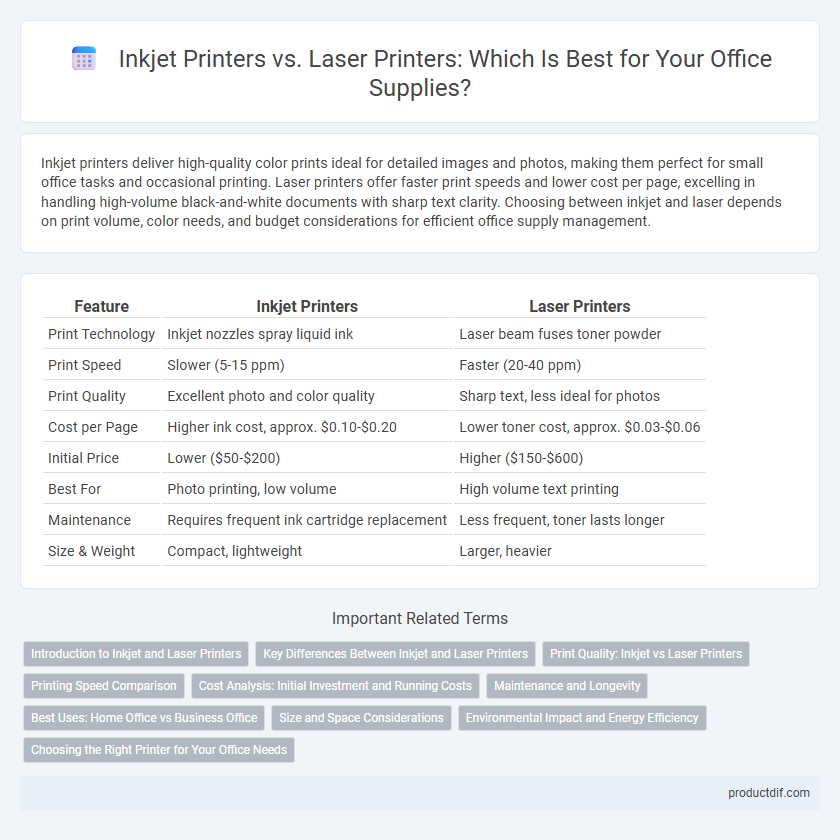Inkjet printers deliver high-quality color prints ideal for detailed images and photos, making them perfect for small office tasks and occasional printing. Laser printers offer faster print speeds and lower cost per page, excelling in handling high-volume black-and-white documents with sharp text clarity. Choosing between inkjet and laser depends on print volume, color needs, and budget considerations for efficient office supply management.
Table of Comparison
| Feature | Inkjet Printers | Laser Printers |
|---|---|---|
| Print Technology | Inkjet nozzles spray liquid ink | Laser beam fuses toner powder |
| Print Speed | Slower (5-15 ppm) | Faster (20-40 ppm) |
| Print Quality | Excellent photo and color quality | Sharp text, less ideal for photos |
| Cost per Page | Higher ink cost, approx. $0.10-$0.20 | Lower toner cost, approx. $0.03-$0.06 |
| Initial Price | Lower ($50-$200) | Higher ($150-$600) |
| Best For | Photo printing, low volume | High volume text printing |
| Maintenance | Requires frequent ink cartridge replacement | Less frequent, toner lasts longer |
| Size & Weight | Compact, lightweight | Larger, heavier |
Introduction to Inkjet and Laser Printers
Inkjet printers use liquid ink sprayed through microscopic nozzles to produce high-quality images, making them ideal for photo printing and detailed color documents. Laser printers utilize toner powder fused onto paper with a heated drum, offering faster print speeds and greater efficiency for high-volume black-and-white or color printing. Both types serve distinct office needs, with inkjet printers excelling in image accuracy and laser printers favored for durability and lower cost per page.
Key Differences Between Inkjet and Laser Printers
Inkjet printers use liquid ink sprayed through microscopic nozzles, producing high-quality color images and photos ideal for detailed graphics and home use, while laser printers utilize toner powder fused by heat, delivering faster print speeds and crisp text, making them cost-effective for high-volume office printing. Inkjet printers generally have lower upfront costs but higher per-page expenses due to ink cartridge replacements, whereas laser printers require larger initial investment but offer lower running costs and greater durability for heavy-duty tasks. Maintenance needs vary: inkjets may suffer from clogging if unused frequently, while laser printers require periodic toner and drum replacement, with each type optimized for different print volume and quality priorities.
Print Quality: Inkjet vs Laser Printers
Inkjet printers excel in producing vibrant color gradients and high-resolution images, making them ideal for photo and detailed graphic printing. Laser printers deliver sharp text and crisp line work with consistent quality, especially suited for professional documents and bulk printing tasks. Choosing between inkjet and laser printers depends on whether print quality preferences prioritize rich color accuracy or fast, precise text output.
Printing Speed Comparison
Inkjet printers typically produce 10 to 15 pages per minute (ppm), making them ideal for low-volume printing tasks. Laser printers offer significantly higher speeds, ranging from 20 to 40 ppm, which suits high-volume office environments. The faster printing speed of laser printers enhances overall productivity and reduces wait times during large print jobs.
Cost Analysis: Initial Investment and Running Costs
Inkjet printers typically have a lower initial investment, costing between $50 and $200, while laser printers start around $150 and can exceed $500. Running costs for inkjet printers are higher due to frequent cartridge replacements and ink refills, averaging $0.05 to $0.15 per page, compared to laser printers' toner cartridges, which cost $0.02 to $0.05 per page but yield higher page counts. Over time, laser printers offer more cost efficiency for high-volume printing despite the higher upfront price, making them ideal for offices with substantial printing needs.
Maintenance and Longevity
Inkjet printers require frequent maintenance due to their susceptibility to ink clogging and drying, often needing regular cleaning cycles to maintain print quality. Laser printers offer greater longevity with less frequent maintenance, as their toner cartridges do not dry out and print mechanisms are less prone to clogging. For high-volume office use, laser printers provide more reliable performance and lower maintenance costs over time.
Best Uses: Home Office vs Business Office
Inkjet printers deliver high-quality color prints ideal for home offices requiring photo and graphic printing with occasional use. Laser printers excel in business offices by offering fast, cost-efficient output and sharp text quality for heavy-volume document printing. Choosing between them depends on the need for vibrant color accuracy versus rapid, high-volume black-and-white or color document production.
Size and Space Considerations
Inkjet printers are typically more compact and lightweight, making them ideal for small office spaces or tight workstations. Laser printers, while bulkier and heavier due to their internal components, offer higher volume printing suited for larger offices with more space. Choosing between the two depends on balancing available space with printing volume and speed requirements.
Environmental Impact and Energy Efficiency
Inkjet printers consume less energy than laser printers, making them more energy-efficient during operation, but they generate more plastic waste due to frequent cartridge replacements. Laser printers, while using more electricity especially during warm-up, produce less waste over time with longer-lasting toner cartridges and generally have higher page yields. Both printer types have distinct environmental footprints, with inkjets favoring lower energy use and lasers reducing material waste.
Choosing the Right Printer for Your Office Needs
Inkjet printers offer superior color accuracy and are ideal for high-quality photo printing, making them suitable for creative tasks and small office use. Laser printers deliver faster printing speeds and lower cost per page, excelling in high-volume document printing and text-heavy output. Evaluating print volume, color requirements, and budget constraints ensures selecting the right printer optimizes office productivity and operational efficiency.
Inkjet printers vs Laser printers Infographic

 productdif.com
productdif.com